Climate Ready Scotland: climate change adaptation programme 2019-2024
A five year programme to prepare Scotland for the challenges we will face as our climate continues to change.
Outcome 6: Our coastal and marine environment is valued, enjoyed, protected and enhanced and has increased resilience to climate change
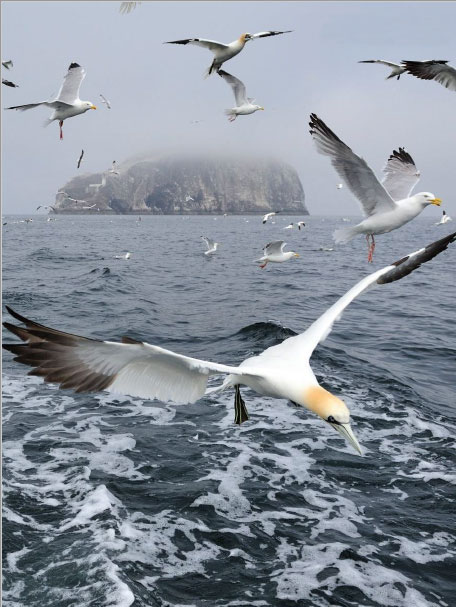
Image 6.1. Bass Rock (© Lorne Gill, SNH)
Introduction
Scottish waters are a special place for marine habitats and wildlife, thanks to the unique combination of:
- our position at the edge of the European continental shelf,
- Scotland’s long coastline and large area of sea,
- the mixing of warm Gulf Stream currents and cold currents.
Glacial activity created our highly intricate coastline, which includes around 800 islands mostly off the west and north coasts. At about 18,000 km long, our coastline would stretch from Scotland to Australia were all of its curves and creases straightened out.
Coastal habitats including sand dunes, cliffs, saltmarsh and saline lagoons are thus a very big part of the Scottish landscape. Machair is a remarkable living landscape that’s unique to Scotland and Ireland.
Scotland’s territorial seas are those found up to 12 nautical miles from the coast. They cover a total area of 90,404 km2. Beyond these 12 miles and out to the limits of the Exclusive Economic Zone, which is the zone where Scotland claims exclusive rights to economic activities, are a further 371,859 km2 of Scottish waters. Our waters combined total 462,263 km2, approximately six times greater than the area of the Scottish mainland and islands added together.
Scotland's seas are positioned between subpolar and subtropical influences and support a spectacular and diverse range of habitats and species. There remains much to be discovered about Scottish marine wildlife, but current best estimates suggest there are tens of thousands of species, from microscopic plants and animals to seals, dolphins and whales.
Scottish seas and coasts also provide many socio-economic roles including fisheries and aquaculture.
Where We Are Now
Scotland’s first Climate Change Adaptation Programme (SCCAP) had a strong focus on protecting Scotland's much loved natural environment. Adaptation has been firmly embedded within the core work of the wider public sector, including a long track record at the Scottish Environment Protection Agency, Scottish Natural Heritage, Scottish Forestry, Historic Environment Scotland and Marine Scotland.
Recent reports have found Scotland’s coastal waters to be in good ecological condition. Targets to designate 10% of coastal waters as protected areas have already been met. As climate change increases pressures on our coastal and marine environments, it is important that we keep working to protect and support these areas, in order to protect this good ecological status.
Coastal erosion is another major factor of concern as the climate changes. Over time, the data on coastal change has significantly improved with Dynamic Coast: Scotland’s National Coastal Change Assessment. In 2017, the Scottish Government launched phase 1 of its Dynamic Coast project, which quantified the coastal changes between the 1890s, 1970s and modern times. Erosion is expanding and quickening in some places. Consequential implications for designated sites, mitigation and adaptation plans are being considered by SNH. The second phase of Dynamic Coast, taking place from January 2018 to March 2020, is investigating the anticipated impact of climate change on future coastal change and erosion exacerbated flooding. Seven ‘super sites’ have also been identified, including St Andrews, Montrose and Skara Brae, where the project will forecast future change, anticipated damage, and develop mitigation and adaptation plans with stakeholders.
The Marine Climate Change Impacts Partnership (MCCIP) brings together scientists, policy makers, government agencies and NGOs to provide coordinated advice on climate change impacts and adaptation in our seas around our coast. Through MCCIP’s Annual Report Cards, the understanding of marine climate change impacts is synthesised in an accessible and actionable way. In 2017, MCCIP published its 10-year report card which summarised our understanding of impacts. Marine Scotland and others have contributed to MCCIP’s Climate Smart Working initiative. This new approach provides a way to explore the issues, challenges, opportunities and achievements in marine climate change adaptation, as well as communicating and celebrating the marine adaptation work that has been taking place in the UK. In 2018, through this project, some case studies were published on climate change and conservation features, including, seagrass, coastal lagoons, coral gardens, saltmarshes, maerl and sand eels as seabird prey. Marine Scotland and Scottish Natural Heritage are providing funding to MCCIP for 2018 – 2019. Both organisations will continue to participate on the MCCIP Steering Group and the Report Card Working Group, which will prepare the next UK marine climate change report cards this year.
The following diagram outlines the structure of the coastal and marine chapter. It is set out by Sub-Outcome providing further detailed policies which follow an ecosystem services approach.
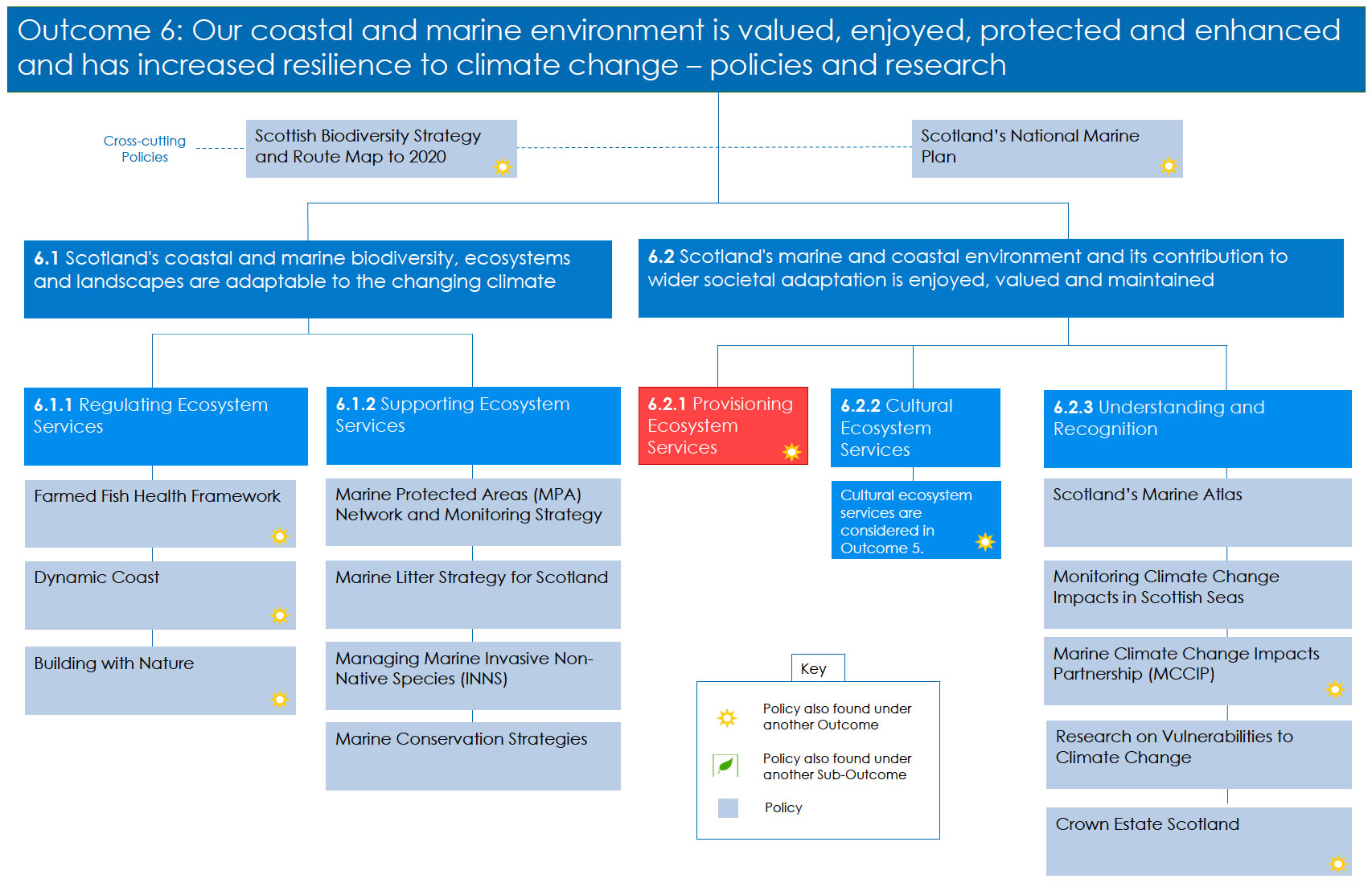
Coastal and Marine Sub-Outcomes
Ecosystem services are the direct and indirect contributions of ecosystems to human well-being. Ecosystem services are vital to society, the economy and the functioning of our natural systems. They are typically split into four categories: provisioning, regulating, supporting and cultural services. Provisioning services are the products obtained from ecosystems. Regulating services are the benefits we obtain from the regulation of ecosystem processes. Cultural services are the non-material benefits that people obtain from ecosystems, while supporting services are those that are necessary for the production of all other ecosystem services. More information on ecosystem services can be found in Outcome 5.
Considering an ecosystem services approach, the four types of services have been split across three Sub-Outcomes. The regulating and supporting services are considered under Sub-Outcome 6.1; the cultural services are considered under Sub-Outcome 6.2, while the provisioning services are being considered under the economy outcome in Sub-Outcome 3.1.
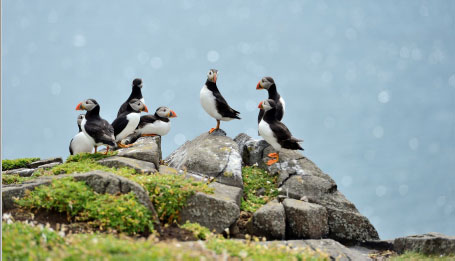
Image 6.2. Isle of May National Nature Reserve (© Lorne Gill, SNH)
Cross-Cutting Policies
The following policies relate to the whole of the outcome. As they are higher level strategies and include many diverse policies and themes, they affect multiple sub-outcomes. Some of the key individual policies within these strategies have been drawn out further below.
| Scottish Biodiversity Strategy and Route Map to 2020 |
|---|
| The strategy and route map aim to protect and restore biodiversity and support healthy ecosystems. More details on this strategy can be found in the Cross-Cutting Policies section of Outcome 5. |
| Scotland’s National Marine Plan |
|
|---|---|
| Adopted on 25 March 2015, the Plan sets out how Scottish Ministers intend marine resources to be used and managed out to 200 nautical miles and applies to all decisions taken by public authorities that affect Scotland’s marine area. The Plan specifies High Level Marine (Strategic) Objectives and core General Policies which apply to all planning and decision making in the marine environment, supplemented by sector specific policies. Each sectoral chapter includes a section on adaptation. Examples of objectives relating to climate change include:
The 1st review of the National Marine Plan was published in March 2018 in line with statutory duties. Scottish Ministers considered the Review Report and decided not to replace or amend the Plan. The review highlighted a number of areas of emerging activity, strategies and policy areas which will influence future Plan policy and content. |
|
| Timeline: The next review of the National Marine Plan should be published on or before 23 March 2021 for Scotland’s offshore area and 23 March 2023 for the inshore area. |
Owners: Scottish Ministers, but applies to all decisions taken by public authorities that affect Scotland’s marine area. |
Sub-Outcome 6.1: Scotland’s coastal and marine biodiversity, ecosystems and landscapes are adaptable to the changing climate
This Sub-Outcome relates to the policies that help with the adaptation of regulating and supporting ecosystem services. Helping nature to adapt will in turn provide us with benefits such as clean water, flood risk management, biodiversity and carbon storage. We must consider the resilience of wildlife, habitats and ecosystems to adapt to our changing climate. Building ecological resilience to address risks to species and habitats is one of the key recommendations of the Climate Change Risk Assessment 2017.
6.1.1 Regulating Ecosystem Services
Regulating services are those that regulate ecosystem processes. These services include natural flood management, carbon sequestration, erosion control, climate regulation, and moderation of extreme events. The following policies address the protection and support related to the regulating services provided by Scotland’s coastal and marine ecosystems.
| Farmed Fish Health Framework |
|---|
| Scotland’s Farmed Fish Health Framework includes a Climate Change and Ocean Acidification subgroup. The subgroup aims to monitor, review and assess the impact of climate change and ocean acidification on Scottish waters. This policy creates a framework to support the adaptation of marine aquaculture to climate change. More details on this policy can be found in Section 3.1.3. |
| Dynamic Coast |
|
|---|---|
| Rising sea levels, increased coastal erosion and erosion-enhanced flooding will progressively impact Scotland’s soft coastlines, its assets and communities. Our ‘natural defences,’ beaches and dunes, are protecting £13bn of assets. Some of these are eroding and £400m assets will be threatened by 2050, if erosion continues. The second phase of Dynamic Coast will investigate the resilience of Scotland’s natural coastal defences (e.g. identifying where low dunes may breach); estimate how future climate change may exacerbate erosion on our soft (erodible) coast; and develop mitigation, adaptation and resilience plans at super sites, including St Andrews and Montrose. |
|
| Timeline: Phase 2 will be completed in 2020. |
Owners: Scottish Government |
| Building with Nature |
|---|
| Building with Nature is an EU Interreg project to gather evidence to support working with natural processes to manage flood risk and coastal erosion, whilst enhancing ecosystem services. More information on this policy can be found in Section 7.2. |
6.1.2 Supporting Ecosystem Services
Supporting services describes those which are necessary for the production of all other services. They differ from other services as their impacts tend to be more indirect to humans or occur over a long period of time. Some examples of supporting services are nutrient cycling, habitat provision and biodiversity. Helping these services to adapt, in turn help to ensure the adaptation of the other types of ecosystem services.
| Marine Protected Areas (MPA) Network and Monitoring Strategy |
|
|---|---|
| The Marine Protected Area (MPA) network has been developed to meet a range of National, European, and International obligations. The primary purpose of the MPA network is to maintain or enhance marine biodiversity. By doing this, the resilience of habitats and species is improved, giving them more space to adapt to the changing climate. The network demonstrates sustainable management, and protects our heritage. Approximately 22% of our seas are covered by the network. Current work is focused on improving the coherence of the network by expanding the range of habitats and species protected, and delivering site specific management measures. A research programme is underway, with the aim of developing a map of blue carbon to better understand its role in mitigating and adapting to climate change. SNH helps to manage the MPAs. They will work closely with key marine stakeholders, including local coastal communities, to trial new approaches to marine management including through marine monitoring and citizen science, and the development of regional approaches to MPA management. The MPA Monitoring Strategy will ensure the necessary information is collected from the Scottish MPA network to underpin assessment and reporting obligations. The strategy is regularly reviewed and updated in collaboration between the partner organisations. |
|
| Timeline: Improving the coherence of the MPA network by 2020, and delivering specific management measures by 2024. |
Owners: Marine Scotland, SNH, Joint Nature Conservation Committee (JNCC) |
| Marine Litter Strategy for Scotland |
|
|---|---|
| Marine litter is a global challenge affecting the world’s oceans, seas and coastlines. It is caused by a range of slowly degrading material including plastics, metals and glass. Of these materials, plastic is the most common. Marine plastics have a negative impact on our marine environment, our economy, and potentially human health. Plastic items in our seas can cause damage to habitats, wildlife entanglement and obstruction and physical damage to animals who ingest them. A reduction in the amount of litter in Scotland’s marine environment will reduce the overall pressure on marine species, leaving more space for them to adapt to the changing climate. Published in 2014, the Marine Litter Strategy aims to develop current and future measures to ensure that the amount of litter entering the marine and coastal environment is minimised to bring ecological, economic and social benefits. The strategy is currently under review to reflect the output of the discussions hosted at the International Marine Conference 2019, and the British-Irish Council Marine Litter Symposium. This will improve focus on actions to affect the most change, including more emphasis on marine litter removal. |
|
| Timeline: The Strategy will be reviewed in 2019-20, and new milestones applied. |
Owners: Owned by Marine Scotland with links to the National Litter Strategy. |
| Managing Marine Invasive Non-Native Species (INNS) |
|
|---|---|
| As Scotland’s climate changes, the marine environment may enable more non-native species to become common and increase pressure on native biodiversity. Some species may expand their range or may be more likely to establish if introduced. It is also possible that some species which are currently benign may become invasive. Marine Scotland will continue to work in partnership with other key authorities such as SEPA and SNH to respond, where feasible, to marine INNS in Scottish waters in order to minimise negative impacts on biodiversity and promote ecological resilience. Marine Scotland will continue to keep under review how it approaches INNS management going forward, including how we work with stakeholders across marine sectors to minimise the threats posed by INNS. |
|
| Timeline: Feasibility of eradication / control of arriving INNS will be assessed and responses undertaken as necessary. |
Owners: Marine Scotland |
| Marine Conservation Strategies |
|
|---|---|
| The Scottish Government is currently developing the Scottish Seabird Conservation Strategy and the UK Dolphin and Porpoise Conservation Strategy. The purpose of the UK Dolphin and Porpoise Conservation Strategy is to deliver and/or maintain a favourable conservation status for nine species of cetaceans in UK waters (to the extent of the continental shelf). The high level actions of the Strategy will enable better delivery of management, research, monitoring and communication. Marine Scotland is working with UK, Welsh and Northern Irish Government departments to develop and, following consultation, implement the Strategy. The Scottish Seabird Conservation Strategy is in the early stages of development. It will include a number of high level actions to optimise the conservation prospects of seabirds in Scotland through effective management of existing and emerging threats. |
|
| Timeline: Consultation on the UK Dolphin and Porpoise Conservation Strategy will take place in 2019. A stakeholder event will take place for the Scottish Seabird Conservation Strategy in 2019 ahead of public consultation. Both strategies are expected to be adopted in 2020. |
Owners: Marine Scotland, SNH, Joint Nature Conservation Committee (JNCC), Department for Environment, Food and Rural Affairs (DEFRA), Northern Ireland Department of Agriculture, Environment and Rural Affairs (DAERA), Natural Resources Wales (NRW) and the Welsh Government. |
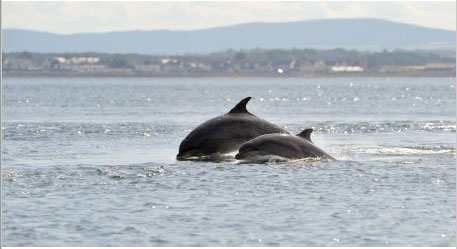
Image 6.3. Bottlenose dolphins, Moray Firth (© Lorne Gill, SNH)
Sub-Outcome 6.2: Scotland’s marine and coastal environment and its contribution to wider societal adaptation is enjoyed, valued and maintained
Helping our coastal and marine environment to adapt also helps sustain us through many intangible ways. It contributes to our health and wellbeing, enjoyment of the outdoors, sense of place and who we are as a nation. The policies under this Sub-Outcome help to ensure that the contributions of the coastal and marine environment to culture are understood, enjoyed and maintained.
6.2.1 Provisioning Ecosystem Services
Provisioning ecosystem services are the products that are obtained from ecosystems, such as: fish and shellfish. Provisioning ecosystem services are often tied to the concept of natural capital. Natural capital is defined as a country’s stock of natural resources and environmental assets including plants, animals, air, water, soils and minerals. Scotland’s natural capital is a source of significant international competitive advantage, and its continuing health and improvement is fundamental to sustainable economic growth. Because of the links to economic growth, these services will be considered under the economy chapter. Policies related to the provisioning of ecosystem services can be found in Sub-Outcome 3.1, which relates to Scotland’s businesses that depend on natural capital, including fisheries and aquaculture. Sub-Outcome 3.1 relates to the risks to natural resource based businesses, where Sub-Outcome 3.3 relates to the opportunities that these businesses have as a result of climatic changes.
6.2.2 Cultural Ecosystem Services
Cultural ecosystem services describe the more intangible or nonmaterial benefits that people receive from ecosystems. These benefits can include mental and physical health and well-being, recreation, tourism, aesthetic values, spiritual and religious values, cultural heritage and sense of place. People’s experiences with the coastal and marine environment are tightly linked with those of the natural environment. For this reason, policies relating to cultural ecosystem services have been included in Section 5.2.2.
6.2.3 Understanding and Recognition
One of the main reasons for using an ecosystem services approach is to provide a framework for understanding and recognising the value of all of the benefits that we receive from the natural environment. We are more likely to care for nature if we have a good understanding of its value. More than just understanding the value of nature, it is also important that we understand our connection to it. As humans, we are also part of ecosystems. We are not separate from nature but part of it. Related to this, it is important that we also recognise the intrinsic value of nature. Our natural systems are valuable not just because of their connection to us as humans, but for its own sake as well. The policies under this sub-outcome help to build our understanding and recognition of the natural environment.
| Scotland’s Marine Atlas |
|
|---|---|
| Scotland’s Marine Atlas (2011) provides an Overall Assessment of the condition of Scotland’s seas, based on scientific evidence. It reported on the Scottish Government’s vision for the seas as ‘clean, healthy, safe, productive, biologically diverse marine and coastal environments, managed to meet the long term needs of nature and people’. The Atlas provides baseline information from which the national marine plan was developed. Since 2011, a large range of spatial information and monitoring data have been added to the MS Maps NMPi (National Marine Plan interactive) web portal to provide more up to date information. |
|
| Timeline: A new Overall Assessment is being prepared for publication in 2020. |
Owners: Marine Scotland |
| Monitoring Climate Change Impacts in Scottish Seas |
|
|---|---|
| Marine Scotland will use marine research strategies and monitoring programmes to gather data on the impact climate change is having within Scottish seas, including:
These data are used to help inform future policy development. |
|
| Timeline: Annual implementation of Marine Scotland Science survey programme. Annual delivery of data to national and international databases. Annual update of climate change impact assessments through ICES (e.g. the ICES Report on Ocean Climate), OSPAR and national (e.g. Scotland’s Marine Atlas) published assessments. |
Owners: Marine Scotland Science |
| Marine Climate Change Impacts Partnership (MCCIP) |
|
|---|---|
| MCCIP collates expertise from across the United Kingdom and uses this to develop high quality evidence supported by scientific consensus – including Annual Report Cards (summaries of current and future CC impacts on specific environment and ecosystem components) and Climate Smart Working Reports (CC adaptation advice for specific marine industry / management sectors). By providing a small financial contribution, Scotland gains a significant added-value process, and quality, peer-reviewed scientific support for adaptation policies. |
|
| Timeline: An annual payment is made to support MCCIP work. |
Owners: Marine Scotland |
| Research on Vulnerabilities to Climate Change |
|
|---|---|
| An ongoing project on intertidal habitat extents will help to identify possible effects of sea level rise at the coast. This will help in understanding the role of intertidal habitats in vulnerability to coastal flooding and erosion, and inform prioritisation of SNH’s future monitoring and management advice. |
|
| Timeline: Ongoing |
Owners: SNH |
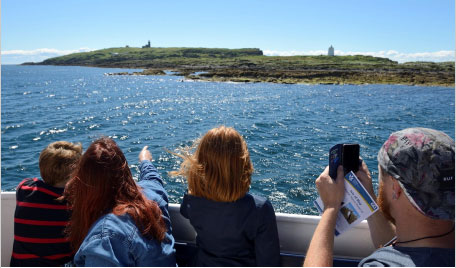
Image 6.4. Isle of May National Nature Reserve (© Lorne Gill, SNH)
| Crown Estate Scotland |
|
|---|---|
| In 2017, decision making powers over a collection of rights, functions and assets owned by the Crown were devolved to Crown Estate Scotland. Crown Estate Scotland is now responsible for:
Marine Scotland will work with Crown Estate Scotland to ensure continued commitment to investments in projects and activities related to the Scottish Crown Estate contribute to climate change adaptation and facilitate wider societal adaptation. To value and maintain the assets they manage, Crown Estate Scotland are undertaking a study to better understand the social, economic and environmental value of the Scottish Crown Estate. A new approach will then be developed to assess the possible social, economic and environmental benefits and impacts of future decision making. This will assist with delivering the new legal framework contained in the Scottish Crown Estate Act 2019, which includes a legal duty to act in a way to further the achievement of sustainable development in Scotland. |
|
| Timeline: Ongoing |
Owners: Marine Scotland |
Adaptation Behaviours
Adapting to climate change requires action from all levels of society. Local government, public bodies, the private sector, third sector, communities and individuals all have a role to play. The behaviours outlined below help individuals and organisations provide opportunities to increase their own resilience and the resilience of the coastal and marine environment to the effects of climate change. With a marine environment under strong pressures as a result of climate change, including warming ocean temperatures and increased acidity, it is important that we help reduce our impact as much as possible. By reducing the pressure we are putting on our ocean environments, we give our marine ecosystems a better chance to be able to adapt.
Individual Behaviours
1. Opt for sustainably sourced or different types of fish. Changing sea temperatures may put pressure on fish that traditionally inhabit Scottish waters. Individuals can help to reduce pressure on these species by choosing to purchase fish that carry an independent sustainability certification, such as the Marine Stewardship Council (MSC) certification or purchasing different types of fish in the supermarket where they are available.
2. Reduce plastic consumption. Ocean plastics are adding additional stress to the marine environment, alongside the effects of climate change. By reducing the amount of plastic we use and throw away, we can help to reduce the pressure on marine ecosystems. Individuals are encouraged to use refillable water bottles or cups or take their own bags to the supermarket.
Societal Behaviours
1. Reduce plastic consumption. Organisations can help support a move away from disposable plastic by offering incentives like discounts for customers who bring their own reusable bottles or cups. Businesses can also work to design packaging and utilise business procedures, staff training and customer engagement to reduce the amount of plastic litter being produced and encourage personal responsibility for the disposal of waste.
2. Flood management in coastal locations. Organisations based near the coast can adapt to some changes and help reduce the impact of flooding. One way of doing this is to promote natural flood defences such as dune systems. This has been particularly successful in golf courses located near the coast. Allowing and encouraging the natural dynamics of dune systems, beaches, and saltmarshes supports valuable coastal habitats and their crucial role in reducing the risk of flooding and erosion.
Monitoring and Evaluation: Outcome 6
Monitoring and Evaluation is integral to the outcomes-based approach which encourages consideration at all stages of adaptation policy development. Further information including a general introduction to the framework, and a description of the foundation and principles can be found in the monitoring and evaluation introduction and Annex 3 respectively.
Key sources of existing monitoring evidence for Outcome 6 include: the National Coastal Change Assessment, Biodiversity Strategy indicators, and Marine Scotland Science. There is currently limited data available for some themes, but by identifying what we need to measure not just what we know we can, the framework highlights monitoring gaps which will be filled as more data and associated monitoring arrangements are developed.
Monitoring the Adaptation Process (‘What are we doing?’) The themes set out the structure to monitor the implementation of and output from adaptation policies and actions which support the Outcome. Indicators will include metrics of, for example: habitat restoration, sustainable resource management, and the extent of marine monitoring.
Monitoring the Sub-Outcomes (‘Is it working?’) The Sub-Outcome monitoring themes highlight the key components of each Sub-Outcome and provide the structure for evaluating progress. Indicators will include metrics of e.g. extent and condition of key habitats, biodiversity, and; progress towards marine conservation objectives.
Monitoring the Outcome Monitoring at this high level will directly link the Outcome to wider government policy and the National Performance Framework by utilising relevant indicators already associated with these high-level monitoring frameworks.
| National Performance Framework Indicators |
Sustainable Development Goals Indicators |
|---|---|
|
|
| Marine Strategy Framework Directive |
|
|
Monitoring and Evaluation Structure: Outcome 6
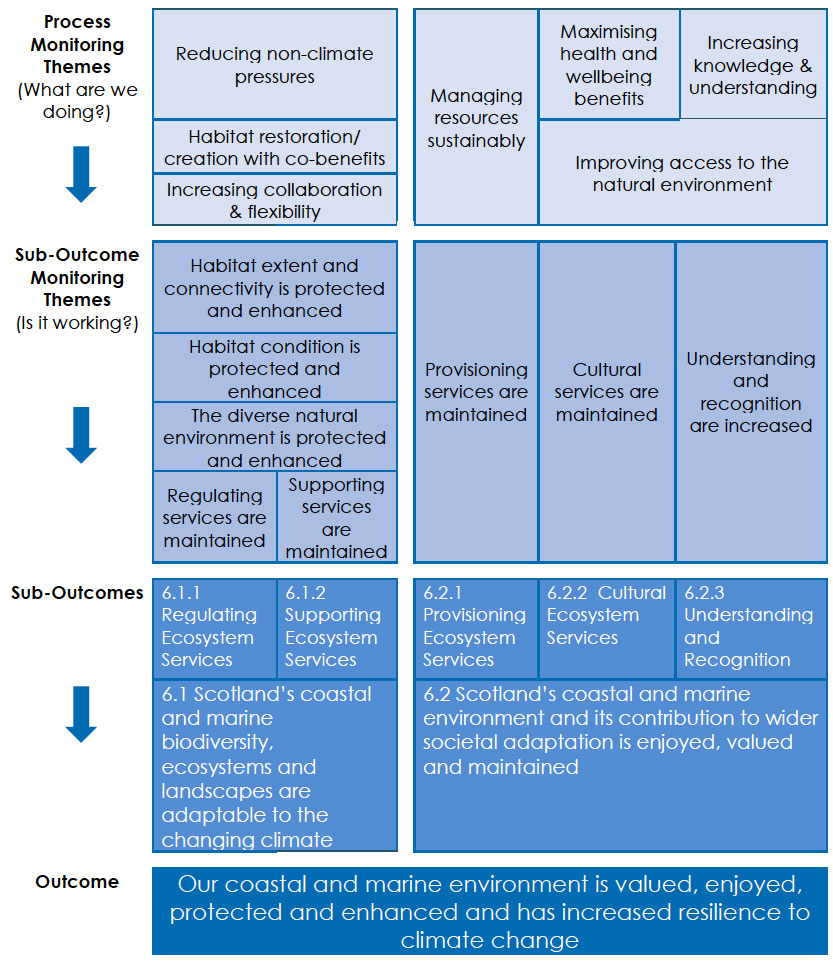
UK Climate Change Risk Assessment: Associated Risks
The UK Climate Change Risk Assessment risks that will be addressed by the policies presented in Outcome 6 are set out below:
| Ne11: |
Ne12: |
Ne13: |
Contact
Email: roddy.maclean@gov.scot
There is a problem
Thanks for your feedback